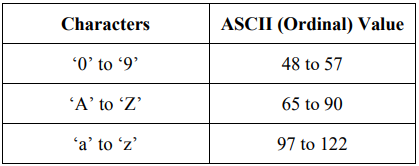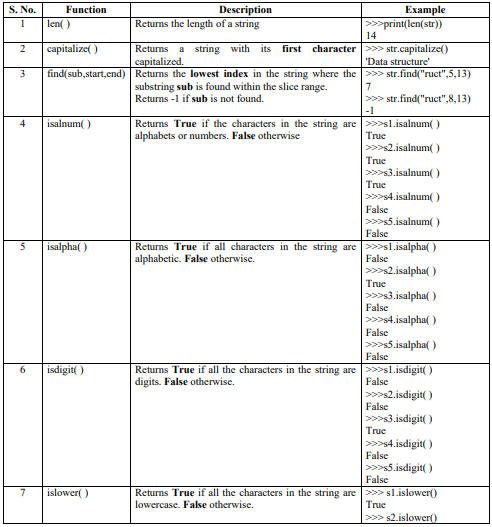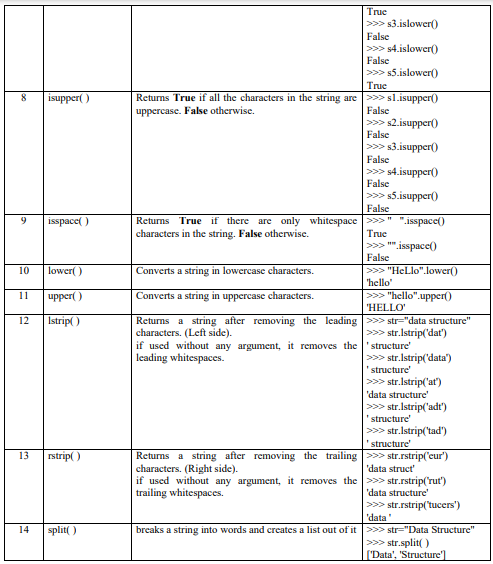| Chapter Name: | String in Python [Chapter 06] |
| Class: | 11th |
| Subject: | Computer Science |
6.1 Introduction: String in Python
Definition – String in Python: Sequence of characters enclosed in single, double or triple quotation marks.
Basic of Strings:
- Strings are immutable in python. It means it is unchangeable. At the same memory address, the new value cannot be stored.
- Each character has its index or can be accessed using its index.
- String in python has two-way index for each location. (0, 1, 2, ……. In the forward direction and -1, -2, -3, …….. in the backward direction.)
Example:

- The index of string in forward direction starts from 0 and in backward direction starts from -1.
- The size of string is total number of characters present in the string. (If there are n characters in the string, then last index in forward direction would be n-1 and last index in backward direction would be –n.)
- String are stored each character in contiguous location.
- The character assignment is not supported in string because strings are immutable
Example:
str=”kendriya”
str[2]=’y’ # it is invalid. Individual letter assignment not allowed in python
6.2 Traversing a String:
Access the elements of string, one character at a time.
str = “kendriya”
for ch in str :
print(ch, end= ‘ ‘)
Output:
kendriya
6.3 String Operators:
- Basic Operators (+, *)
- Membership Operators ( in, not in)
- Comparison Operators (==, !=, <, <=, >, >=)
a) Basic Operators (+, *)
There are two basic operators of strings:
- String concatenation Operator (+)
- String repetition Operator (*)
1 ) String concatenation Operator: The + operator creates a new string by joining the two
operand strings.
Example:
>>>”Hello”+”Python”
‘HelloPython’
>>>’2’+’7’
’27’
>>>”Python”+”3.0”
‘Python3.0’
Note: You cannot concatenate numbers and strings as operands with + operator.
Example:
>>>7+’4’ # unsupported operand type(s) for +: ‘int’ and ‘str’
It is invalid and generates an error
2) String repetition Operator: It is also known as String replication operator. It requires
two types of operands- a string and an integer number.
Example:
>>>”you” * 3
‘youyouyou’
>>>3*”you”
‘youyouyou’
Note: You cannot have strings as n=both the operands with * operator.
Example:
>>>”you” * “you” # can’t multiply sequence by non-int of type ‘str’
It is invalid and generates an error.
b) Membership Operators:
in – Returns True if a character or a substring exists in the given string; otherwise False
not in – Returns True if a character or a substring does not exist in the given string; otherwise False
Example:
>>> “ken” in “Kendriya Vidyalaya”
False
>>> “Ken” in “Kendriya Vidyalaya”
True
>>>”ya V” in “Kendriya Vidyalaya”
True
>>>”8765″ not in “9876543”
False
c) Comparison Operators:
These operators compare two strings character by character according to their ASCII value.

Example:
>> ‘abc’>’abcD’
False
>>> ‘ABC'<‘abc’
True
>>> ‘abcd’>’aBcD’
True
>>> ‘aBcD'<=’abCd’
True
6.4 Finding the Ordinal or Unicode value of a character:

Example:
>>> ord(‘b’)
98
>>> chr(65)
‘A
Program: Write a program to display ASCII code of a character and vice versa.
var=True
while var:
choice=int(input(“Press-1 to find the ordinal value \n Press-2 to find a character of a value\n”))
if choice==1:
ch=input(“Enter a character : “)
print(ord(ch))
elif choice==2:
val=int(input(“Enter an integer value: “))
print(chr(val))
else:
print(“You entered wrong choice”)
print(“Do you want to continue? Y/N”)
option=input()
if option==’y’ or option==’Y’:
var=True
else:
var=False
6.5 Slice operator with Strings:
The slice operator slices a string using a range of indices.
Syntax:
string-name[start:end] where start and end are integer indices. It returns a string from the index start to end-1.
Example:
>>> str=”data structure”
>>> str[0:14]
‘data structure’
>>> str[0:6]
‘data s’
>>> str[2:7]
‘ta st’
>>> str[-13:-6]
‘ata str’
>>> str[-5:-11]
‘ ‘ #returns empty string
>>> str[:14] # Missing index before colon is considered as 0.
‘data structure’
>>> str[0:] # Missing index after colon is considered as 14. (length of string)
‘data structure’
>>> str[7:]
‘ructure’
>>> str[4:]+str[:4]
‘ structuredata’
>>> str[:4]+str[4:] #for any index str[:n]+str[n:] returns original string
‘data structure’
>>> str[8:]+str[:8]
‘ucturedata str’
>>> str[8:], str[:8]
(‘ucture’, ‘data str’)
Slice operator with step index:
Slice operator with strings may have third index. Which is known as step. It is optional.
Syntax:
string-name[start:end:step]
Example:
>>> str=”data structure”
>>> str[2:9:2]
‘t tu’
>>> str[-11:-3:3]
‘atc’
>>> str[: : -1] # reverses a string
‘erutcurts atad’
6.6 Built-in functions of string in Python:
Example:
str=”data structure”
s1= “hello365”
s2= “python”
s3 = ‘4567’
s4 = ‘ ‘
s5= ‘comp34%@’


 Class Notes NCERT Solutions for CBSE Students
Class Notes NCERT Solutions for CBSE Students





